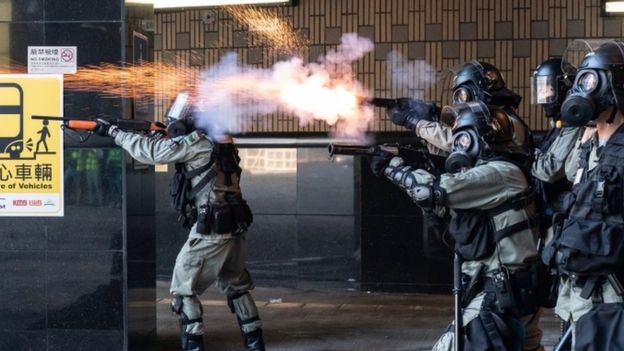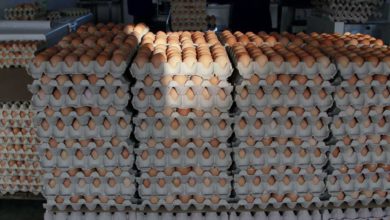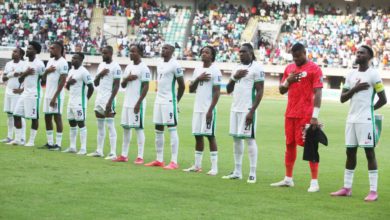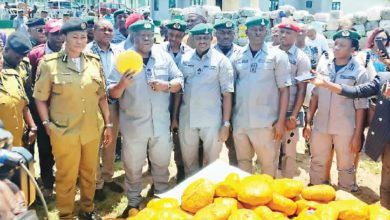
- Police are surrounding a Hong Kong university campus after a fiery overnight stand-off with hundreds of protesters inside.
Police are surrounding a Hong Kong university campus after a fiery overnight stand-off with hundreds of protesters inside.
Dozens of protesters tried to leave after sunrise but turned back as police fired tear gas and rubber bullets.
The police said tear gas was fired because “a large group of masked rioters…suddenly charged at cordons”.
In the afternoon, another group of protesters tried to run from the campus but many were arrested.
The group of around 100 tried to leave Polytechnic University by a tunnel entrance, but as police fired tear gas, a number were detained.
Others from the group then retreated to the campus.
Police officers had previously said protesters could leave the campus via Cheong Wan Road South Bridge, but urged them to drop their weapons and remove their gas masks.
But one pro-democracy legislator inside the campus, Ted Hui, said the bridge had already “been sealed off” – and it was not possible to leave this way.
Some 1,000 people – many of whom are students – still remain on campus, according to Mr Hui.
He added that many on campus were injured and cut off from medical services, calling it a “dire” situation.
The acting president of PolyU’s student union Ken Woo had previously told broadcaster RTHK that at least 500 people remained inside the campus.
He added that fresh water was available, but food supplies were running low. Demonstrators have been occupying the site for days, as Hong Kong’s violent protests continue to escalate.
Earlier, the head of the university, Professor Jin-Guang Teng, released a video statement to protesters, saying he had arranged a deal with the police.
If protesters left peacefully, he said he would “personally accompany” them to the police station where he would “ensure your case is fairly processed”.
Meanwhile, a Hong Kong court has just ruled that the government’s anti-mask law is unconstitutional.
In October the government invoked a colonial-era emergency law to make wearing masks illegal. However, protesters have largely defied this and continued to cover their faces to hide their identities.
What is happening at the university?
The campus has been occupied by protesters for several days, and a statement from the university on Sunday night said it had been “severely and extensively vandalised”.
Overnight, protesters threw petrol bombs and bricks at police, and even fired arrows from bows.
The BBC’s Gabriel Gatehouse, who was at the scene, said there was a game of “cat and mouse” with police.
“The police fire tear gas and the water cannon advances, squirting noxious blue liquid,” he said.
“The protesters, crouching behind umbrellas, respond with petrol bombs and rocks fired from improvised catapults. The police vehicles retreat. The net result is zero.”
When police tried to enter the campus at around 0530 local time, they were met with petrol bombs, which started more fires around the site.
After dawn broke, dozens of protesters tried to leave the site – but turned back after being met with tear gas and rubber bullets.
One student told the Reuters news agency: “At first I felt very scared and panicked staying here, because the police said all of us inside the university would be arrested for charging riots and we will be sentenced for 10 years or above.
“But now I feel very peaceful because I believe that everyone inside our university will stay together.”
On Sunday night, police warned they could use live ammunition.
“I hereby warn rioters not to use petrol bombs, arrows, cars or any deadly weapons to attack police officers,” police spokesman Louis Lau said.
“If they continue such dangerous actions, we would have no choice but to use the minimum force necessary, including live rounds, to fire back.”
On Sunday, a member of police staff was hit in the leg with an arrow apparently fired by a protester from a bow.
Who are the protesters left inside?
In interviews with media, a number of them identified themselves as current students.
But it is unclear now how many of those left on the PolyU campus are, in fact, university students. The protesters earlier appealed for university alumni and others sympathetic to the cause to join them as reinforcements.
By Sunday evening, PolyU officials said the campus had been “occupied by activists”. They also urged all staff and students to evacuate.
Democratic Party politician Hui Chi-fung, who is currently on campus, told a radio station on Monday that many of the remaining protesters appeared to be young teens and secondary school students.
How did we get here?
Campuses had remained relatively free of violence during the ongoing Hong Kong protests but earlier last week, the Chinese University of Hong Kong became a battleground.
Police said protesters threw petrol bombs on to a major road near the university in an effort to stop traffic. Officers attempted to reclaim the road – leading to major clashes.
The university then cancelled all classes for the rest of the term.
Days later, protesters at PolyU also tried to block access to a key tunnel near the university.
“We occupied the streets next to the campus because it’s the Cross Harbour Tunnel,” one 23-year-old protester told NBC News.
“If we could first jam the traffic, then people couldn’t go to work and the economy in return would suffer.”
On Monday the city’s Hospital Authority said 24 people aged between 16-84 were injured, with four in serious condition across Hong Kong.
Some 13 people, aged between 22 and 57, were injured on Sunday, with one in serious condition. It is unclear how many of the injured were protesters at the university.
Why are there protests in Hong Hong?
Hong Kong – a British colony until 1997 – is part of China under a model known as “one country, two systems”.
Under this model, Hong Kong has a high degree of autonomy and people have freedoms unseen in mainland China.
The protests started in June after the government planned to pass a bill that would allow suspects to be extradited to mainland China.
Many feared this would undermine the city’s freedoms and judicial independence.
The bill was eventually withdrawn but the protests continued, having evolved into a broader revolt against the police, and the way Hong Kong is administered by Beijing.



